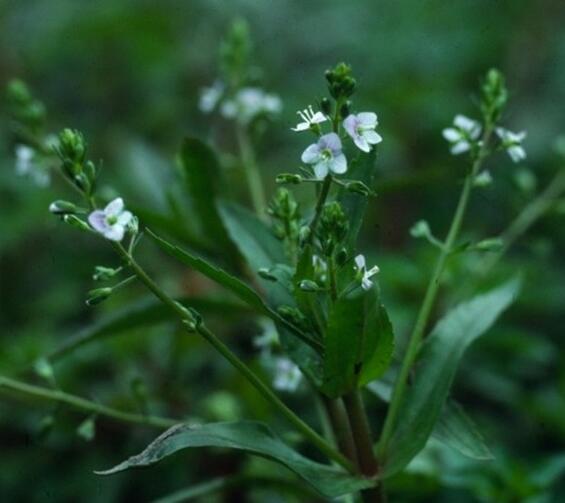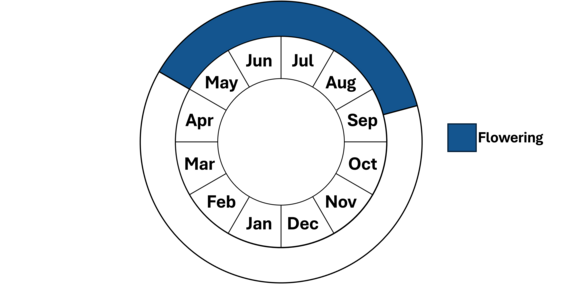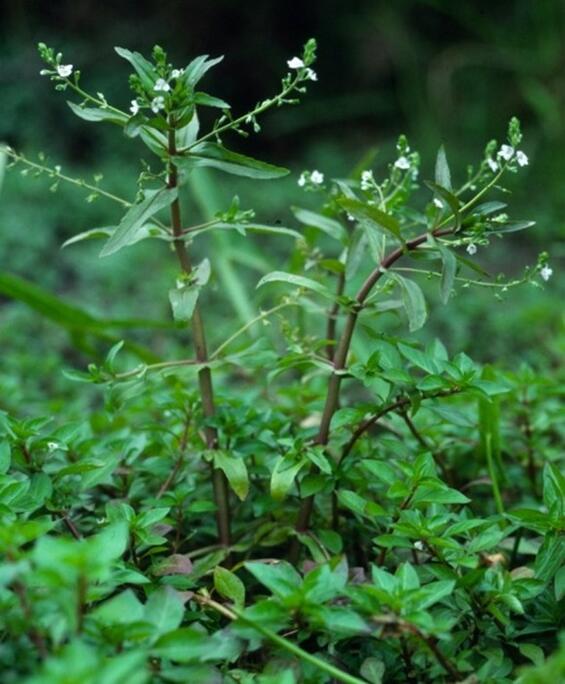- Scientific name: Veronica catenata Pennell
- Species of Greatest Conservation Need (MA State Wildlife Action Plan)
- Endangered (MA Endangered Species Act)
Description

A close view of the four-parted pale flowers. Photo by: B.A. Sorrie, NHESP.
Sessile water-speedwell is a perennial wetland wildflower of rich open wetlands. It is currently classified within the plantain family (Plantaginaceae) but was formerly within the figwort family (Scrophulariaceae) and appears as such in many floras. The species name “catenata” means chain and the name refers to the chain-like aspect of the long racemes of flowers on short pedicels. In habit sessile water-speedwell can be trailing or erect. The stems are light green, glabrous, and rather stout. The leaves are entire or nearly entire (i.e., toothless), and lance-shaped, three to five times longer than wide. They are opposite and sessile to the stem. The four-parted flowers are white, pink, or pale bluish, 3-5 mm (0.1-0.2 in) wide, with blunt-tipped sepals. The flowers are borne on long axillary racemes, which are widely spreading when mature. The flowers bloom just a few at a time. Each flower is replaced by a swollen capsule, longer than it is wide, topped by a conspicuous notch. Sessile water-speedwell can reproduce rhizomatously.
Aids to identification:
- Four-parted, pale-colored flowers, 3-5 mm (0.1-0.2 in) wide
- Numerous (20 to over 50) flowers borne on long, axillary racemes
- Sessile, narrow, hairless leaves, much longer than wide
- Fruit with notch at the tip
Blue water-speedwell (Veronica anagallis-aquatica) is an exotic plant that is very similar to sessile water-speedwell. Some floras lump the two species, and in some areas the two are known to hybridize.
Compared to sessile water-speedwell, blue water-speedwell has leaves that are more elliptical in shape (1.5-3 times longer than wide), larger flowers (5-8 mm wide; 0.2-0.3 in) with more acutely-tipped sepals, mature pedicels that are more ascending (than spreading), and fruit with a much less conspicuous notch. All other congeners in Massachusetts have one or more characters not shared by these two species; these have hairy leaves, distinct leaf petioles, and terminal (rather than axillary) flower racemes.
Life cycle and behavior
This is a perennial species.

Population status
Sessile water-speedwell is listed under the Massachusetts Endangered Species Act as Endangered. All listed species are protected from killing, collecting, possessing, or sale and from activities that would destroy habitat and thus directly or indirectly cause mortality or disrupt critical behaviors. MassWildlife’s Natural Heritage & Endangered Species Program database has 3 records from 1 county (Berkshire). None of those records are within the last 25-year period.
Distribution and abundance

Sessile Water-speedwell with erect stems growing from sprawling leafy stems. Photo by: B.A. Sorrie, NHESP.
In New England, this species only occurs in Massachusetts and Vermont in one county each and is Endangered in both states.
According to several sources including NatureServe (2025) and Dodds (2023) “Comprehensive understanding of Veronica catenata is hampered by the plant's long history of entanglement and confusion with V. anagallis-aquatica as well as several other previously described species and subtaxons with overlapping characteristics that have since been discarded” (Dodds 2023).
Habitat
Sessile water-speedwell inhabits springs and seeps, and the edges of slow-flowing streams, muddy ponds, temporary pools, and ditches. It requires abundant soil moisture for germination and flowering and tolerates water level fluctuation well. Associated species include sweet flag (Acorus americanus), water purslane (Ludwigia palustris), lesser water-plantain (Alisma subcordatum), shining willow (Salix lucida), and bald spike-rush (Eleocharis erythropoda).
Healthy habitats are vital for supporting native wildlife and plants. Explore habitats and learn about conservation and restoration in Massachusetts.
Threats
Threats include degradation of habitat quality due to changes in hydrologic regime or water quality, and competition and shading by aggressive native and invasive plants.
Conservation
The habitats of sessile water-speedwell should be monitored for invasions of exotic plants and tall native woody plants; if the rare wildflower is threatened by over-shading or competition, a vegetation control plan should be constructed and implemented. All active management of rare plant populations (including invasive species removal) is subject to review under the Massachusetts Endangered Species Act and should be planned in close consultation with MassWildlife’s Natural Heritage Endangered Species Program.
As this plant is difficult to find and identify and no current populations exist, much more survey work is needed to locate new or relocate former populations.
References
Dodds, Jill S. 2023. Veronica catenata Rare Plant
Profile. New Jersey Department of Environmental Protection, State Parks, Forests & Historic
Sites, State Forest Fire Service & Forestry, Office of Natural Lands Management, New Jersey
Natural Heritage Program, Trenton, NJ. 15 pp.
Flora Europaea Editors. 1972. Flora Europaea Volume 3: Diapensiaceae to Myoporaceae. Cambridge University Press.
Gleason, H.A., and A. Cronquist. 1991. Manual of Vascular Plants of Northeastern United States and Adjacent Canada. New York Botanical Garden Press, Bronx, New York.
Haines, A. 2011. Flora Novae Angliae. New England Wild Flower Society, Yale University Press, New Haven, CT.
Heckard, L., and P. Rubtzoff. 1977. Additional Notes on Veronica anagallis-aquatica x catenata (Scrophulariaceae). Rhodora 79: 579–581.
NatureServe. 2025. NatureServe Network Biodiversity Location Data accessed through NatureServe Explorer [web application]. NatureServe, Arlington, Virginia. Available https://explorer.natureserve.org/. Accessed: 5/5/2025
Pennell, F.W. 1935. The Scrophulariaceae of eastern temperate North America. Acad. Nat. Sci. Philadelphia Monogr. 1.
Contact
| Date published: | May 7, 2025 |
|---|